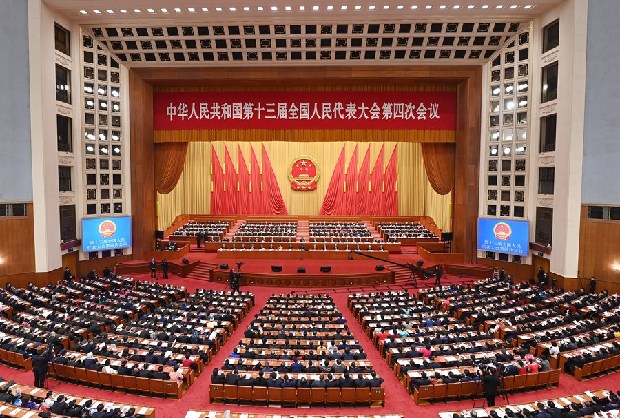China's top legislative body on Thursday approved a development blueprint for the next five to 15 years to guide the country's march toward modernization, a dream pursued by many generations of Chinese.
After a week of deliberations, the lawmakers adopted the Outline of the 14th Five-Year Plan (2021-2025) for National Economic and Social Development and the Long-Range Objectives Through the Year 2035 at the closing meeting of the fourth session of the 13th National People's Congress (NPC).

The closing meeting of the fourth session of the 13th National People's Congress is held at the Great Hall of the People in Beijing, March 11, 2021. (Xinhua/Jin Liangkuai)
"The outline serves as a roadmap toward the country's second centenary goal of fully building a modern socialist country, ushering China into a new stage of development," said Wang Honghai, an NPC deputy and Party chief of Ninghe District of Tianjin Municipality.
With 55.75 million rural residents lifted out of poverty over the past five years, China will meet its first centenary goal within the set time frame -- complete building a moderately prosperous society in all respects.
To develop in only 70 years, a single lifetime, is a stupendous achievement -- in fact one not matched previously by any large country in the whole of human history, said John Ross, a British academic and senior fellow at Chongyang Institute for Financial Studies of Renmin University of China.
GOVERNANCE TRADITION
China has long been hailed for thinking strategically and playing the long game.

Photo taken on Sept. 11, 2020 shows the city view of Shenzhen in south China's Guangdong Province. (Xinhua/Mao Siqian)
China's five-year plan is one of the country's most important policy blueprints. Drawn up since 1953, it sets long-term goals for China's social and economic development and is the barometer against which progress is measured.
The formulation of such plans is regarded as a crucial tool for macroeconomic governance and social management, and also a key to the country's stellar development over the past few decades.
The outline of the 14th five-year plan and the longer-term program to 2035 depicts the future landscape of how China will develop "as a high-income economy," Ross said.
"The continuity of China's policies will inject the much-needed stability and certainty to the world roiled by the deadly COVID-19 pandemic," said Bai Yongxiu, a professor at Northwest University.
FLEXIBLE ECONOMIC TARGETS
Avoiding announcing an explicit economic growth target for the next five years, China aims to keep its economy running within an appropriate range and will set annual economic targets in light of actual circumstances, the outline said.

Photo taken on Feb. 24, 2021 shows a molten-salt solar thermal power plant in Dunhuang, northwest China's Gansu Province. (Xinhua/Ma Xiping)
"This shows that China will focus on high-quality growth and not just chase after quantitative expansion. It will give local authorities more room to allocate resources to other initiatives to tap into China's long-term growth potential," said Bai.
Li Daokui, a national political advisor and an economist with Tsinghua University, said by setting flexible growth targets, China can concentrate on deep structural issues such as unleashing domestic demand and raising innovation capacity.
The key document also includes an array of other benchmark economic indicators such as an urbanization rate of 65 percent, a surveyed urban unemployment rate of lower than 5.5 percent and drastically-slashed carbon emissions per unit of GDP in the next five years.
"The major benchmark indicators set in the outline (for China to achieve) are just like peaches on a tree that can only be picked if one jumps hard," said He Lifeng, head of the National Development and Reform Commission. "And we have to jump hard."
Reiterating innovation's "core position" in the country's march toward modernization, the outline stressed that China will make technological self-sufficiency strategic support for national development.
China's R&D spending will increase by more than 7 percent per year over the next five years, accounting for a higher percentage of GDP than that in the past five years, according to the document.
MODERNIZATION DRIVE
In October 2017, the Communist Party of China unveiled a two-stage plan to build the world's most populous nation into a "great modern socialist country" that is "prosperous, strong, democratic, culturally advanced, harmonious and beautiful" by the middle of the 21st century. According to the plan, China will basically realize socialist modernization in the first stage from 2020 to 2035.

Children study in their new house at the relocation site in Gangdoi Town, Gonggar County, southwest China's Tibet Autonomous Region, Jan. 20, 2020. (Xinhua/Chogo)
One significant feature of China's modernization is to improve people's wellbeing, as evidenced by the country's herculean efforts to eradicate poverty over the past years and its COVID-19 containment measures that always put people's health and safety first.
"Modernity has always been pluralistic, and there is no unified plan for modernization," said Chen Shuguang, a professor at the Party School of the Communist Party of China Central Committee. "It is increasingly clear that the modernization China seeks will not be a mere replica of the Western one."
FRESH OPPORTUNITIES FOR WORLD
In its gradual and concrete approaches to modernization, China is expected to continuously share with the world its development opportunities to drive global growth hindered by the COVID-19 pandemic and the rising sentiment of protectionism and unilateralism.

Photo taken on Feb. 22, 2021 shows a container terminal of Tianjin Port in north China's Tianjin Municipality. (Xinhua/Zhao Zishuo)
Rising incomes and more complex needs of the Chinese people will transform and expand numerous global markets associated with high living standards -- culture, education, entertainment, travel, health care and environmental protection, Ross said.
China has a population of 1.4 billion and a middle-income group that exceeds 400 million. "The world stands to benefit from the vastly huge market as China will step up opening-up efforts and continue to support economic globalization," said Zhang Shuibo, a national political advisor and professor at Tianjin University.
A more prosperous and strong China will not only further unleash market potential, but also be more capable of helping other countries and shoulder international responsibility, Zhang said.




